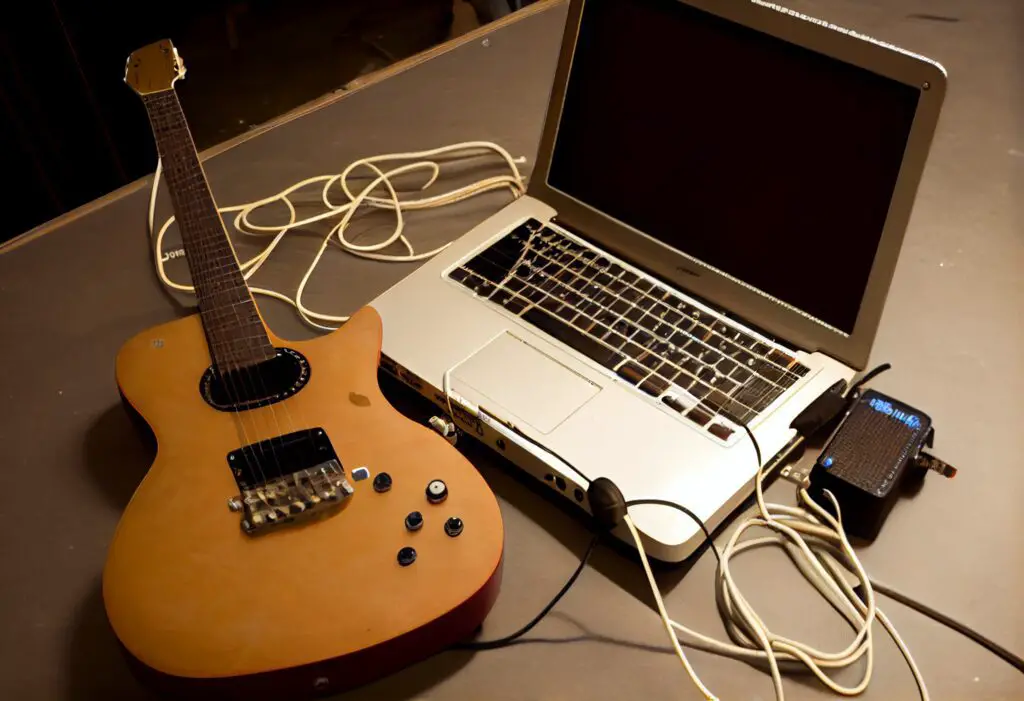Connecting a guitar to a PC without an audio interface can seem daunting, but fortunately, there are several ways to achieve this. Getting your guitar recorded directly onto your computer allows for seamless editing and mixing of your music without needing physical recording gear.
One approach to connecting your electric guitar to a PC without an audio interface is using your computer’s built-in microphone or a mic designed for the mic input. Another option is to use a multi-effects pedal or an acoustic guitar amp with a USB out.
In the following article, we will explore these methods in detail to help you get started with connecting your guitar to your computer without an audio interface.
Table of Contents

Using a Microphone
Another method to connect a guitar to a PC without an interface is using a microphone. You can consider a few options depending on your setup and available resources.
One option is to use your laptop’s built-in microphone if it has one. Place your laptop near your guitar amp and record the sound. Remember that this method may not produce the best audio quality, as built-in microphones aren’t designed to record musical instruments.
Another approach is using an external microphone to connect directly to your computer’s mic input (pink receptacle). Place the microphone in front of your guitar amp or close to your acoustic guitar, and adjust its position to achieve the desired sound quality.
If you have a USB microphone, you can use this as well. USB microphones typically offer better audio quality than built-in microphones and can be connected directly to your computer without an audio interface. Follow the manufacturer’s instructions on setting up and configuring the USB microphone with your recording software.
For those with an XLR microphone but no audio interface, an XLR-to-USB adapter, such as the Shure X2U XLR-to-USB adapter, can be used. This adapter lets you connect your XLR microphone directly to a USB port on your computer, effectively bypassing the need for an audio interface.
Rocksmith Real Tone Cable
The Rocksmith Real Tone Cable is ideal for connecting your guitar to your PC without an audio interface. This cable is specifically designed for Rocksmith users, allowing you to play the game without needing an external audio interface.
The Rocksmith Real Tone Cable is a USB-to-guitar cable directly connecting your guitar to your computer’s USB port. It’s compatible with electric guitars and basses and is designed to provide a high-quality signal for Rocksmith and other computer-based programs.
To use the Real Tone Cable, plug the 1/4-inch connector into your guitar’s output jack and the USB connector into your computer’s USB port. Once connected, your computer should automatically recognize the cable and install the necessary drivers.
The Real Tone Cable can also be a basic audio interface for those who want to use other applications or recording software. However, it’s important to note that its primary purpose is to play the Rocksmith game. It may not offer the same versatility and control as dedicated audio interfaces.
You can substitute the Real Tone Cable with a third-party USB-to-guitar cable or an audio interface if you’re looking for an alternative or a more professional setup for recording purposes.
USB Guitar Cables
USB guitar cables are an affordable and straightforward option for connecting your electric guitar to your PC without using an audio interface. These cables have a 1/4-inch instrument input on one end for connecting to your guitar and a USB connector on the other for connecting to your computer.
Install any required drivers for the cable to work with your computer when using a USB guitar cable. Some USB guitar cables include built-in audio processing functionalities, while others may require additional software for audio processing and effects, like Guitar Rig or Amplitube.
Remember that USB guitar cables may not offer the same audio quality or latency performance as a dedicated audio interface, which can be crucial for recording or live performance situations. However, they can be a suitable option for practice, casual recording, or if you’re on a tight budget.
Here are a few popular USB guitar cables to consider:
When using a USB guitar cable, adjusting the buffer size and sample rate settings in your digital audio workstation (DAW) or other guitar processing software is essential to minimize latency and optimize audio quality.
Conclusion
In summary, connecting your electric guitar to a PC without an audio interface is possible through various methods. The simplest option is to use your laptop’s built-in microphone to record your guitar played through an amp in the room.
Another method involves connecting your guitar to your amp and then using a 3.5mm jack plug from the headset exit into your PC’s microphone input.
Other alternatives include recording with your phone or laptop, using an external microphone, or even using a cassette recorder. You may also consider experimenting with virtual instruments to achieve the desired sound without an audio interface.
Each method has pros and cons, so evaluating your needs and goals is crucial when choosing the most suitable solution.
Investing in an audio interface may provide better sound quality and functionality. However, you can still achieve satisfactory results by utilizing the available resources and making clever use of the tools and software on your PC. Happy recording!
- Review of the ALABS IRON MINI-WL: A Powerhouse Wireless Microphone - October 4, 2023
- What is a Saturator in Music Production: A Brief Explanation - May 11, 2023
- What Are Rotary DJ Mixers? An Overview - May 11, 2023
SoundStudiomagic.com is a participant in the Amazon Services LLC Associates Program, an affiliate advertising program designed to provide a means for sites to earn advertising fees by advertising and linking to Amazon.com. We also participate in other affiliate programs which compensate us for referring traffic.


